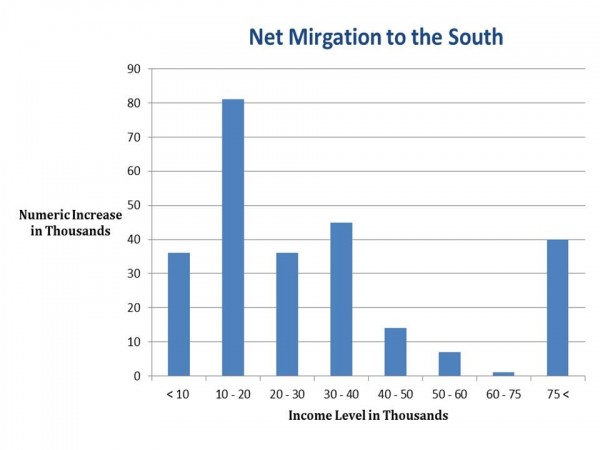In the last year alone, Texas has doubled-down on efforts to blaze its own educational path. The state sought a waiver from No Child Left Behind, voted against joining the Common Core Standards, and approved a sweeping education bill designed to regulate how Texas schools are assessed (House Bill 5). But outside the assumed mantra that “Texas does what’s best for Texas,” one should ask, why is Texas tackling education alone?
Americans are moving to Texas and the South
From 2012 to 2013, the Southern region of the United States experienced large inflows of U.S. citizens from the Northeast, Midwest, and Western regions. When the numerical outflows and inflows of immigration are combined across regions, the South shows significant population increases across lower-, middle-, and upper-class income levels. These citizens work in a variety of industries, but the three leading occupational fields for these individuals are business services or health and education services. While several states are accounting for the Southern “in-migration,” Texas is playing a leading role.
Texas’ large metropolitan areas are growing just as fast, or faster, than the rest of the nation’s largest metropolitan areas. From July 2011, to July 2012, Dallas and Houston experienced the largest numeric increases among metropolitan areas with 131, 879, and 125, 185, respectively. But it’s not just the metropolitan areas that are accounting for these population increases. 11 of the 50 fastest growing counties are situated in Texas, and according to demographer William Frey, more than half of Texan infants are non-white. A wide swath of this population resides along the Texas-Mexico border. An important question is whether this young population will identify with the social, political, and educational concerns of the metropolitan areas (including the state capital), or whether a division will grow amongst these very distant population centers?
The increase of an immigrant population is often cited as the primary reason Texas will eventually shade from a red state to a blue state. With so many people coming from other regions of the United States, they will bring their social and political beliefs with them. But it is just as important to ask how this increase in population will affect the education system across the state?
Young immigrants will change educational structures
The 2010 Census shows Texas has the highest percentage of foreign-born individuals, as well as those who speak another language besides English at home. A growing presence of first-generation Texans whose parents may not be native English speakers will test different school districts’ abilities to communicate effectively. How will Texas create uniform standards across large geographic areas that have different education needs, especially in terms of staffing and possibly in terms of curricula?
Subsequently, two other identifiable traits will heavily impact the future of education in Texas. First, the percentage of people aged 25 and over with high school degrees or college degrees is not as high as the national percentage. According to a Brookings report published after the 2010 Census was released, Texas cities already possess large numbers of “low skilled” immigrant workers, as opposed to metro areas like Washington or Raleigh that hold very large percentages of “high skilled” immigrant workers (i.e. individuals who currently hold college degrees and are, more often than not, upper-middle class workers). Historically, Texas has had trouble adequately preparing the large number of individuals that attend its K-12 institutions. While the “low-skilled” workers over the age of 25 will not be helped directly by a revamped education system, these individuals will most likely have children who will benefit directly from changes to the education system.
Second, Texas has a higher percentage of people living under the national poverty level. If professionals and “high skilled” workers continue moving into Texas to fill unstaffed jobs, how will people living under the poverty level attempt to pull themselves out of it? When these trends are extrapolated over time, it is easy to see a dangerous situation where even more students are financially unable to attend college or must forego a high school diploma. The uphill battle that impoverished students face is already well-noted, but if Texas cannot find a way to improve its economic parity, educational preparedness, and school standards, many more students are going to be shuffled through the system only to drop out or be handed a high school diploma without any real, employable skillsets.
Lastly, the population percentages of people under the ages of both 18 and 5 (many of whom are the foreign-born or multilingual residents) are higher in Texas than the national average, meaning Texas will be attempting to educate more students over a prolonged period of time. Texas cannot simply plan for a long-term future, but it must do so with its eye on the present. While Texas investigates the reforms that will benefit a more diverse population in five or ten years, it must also make immediate reforms that will best suit the students already sitting in middle and high school classes. More students will provide more challenges as the state embarks on its solitary process of sweeping education reform.
What Texas should realize
With a growing percentage of young people, Texas will help determine how effectively large areas of low-income, foreign born, and historically disadvantaged students can or cannot be elevated by K-12 education. While transforming the education system in Texas may not directly benefit the “low skilled” workers already living in Texas, it will undoubtedly benefit their children; a well-rounded education system will help every child over an extremely diverse geographic, social, and cultural state. Hopefully Texas will identify the challenges ahead and work towards establishing a two goal system to raise both the high school and college graduation rates, simultaneously considering economic realities and striving to provide every child the tools to accomplish his or her dreams.
Since the Great Recession, media outlets and government officials have continued to argue that a wide variety of U.S. citizens will need expanded access to technical training, community colleges, and revamped college curricula to meet the demands of a technologically advancing world and an oversaturated labor market. While this is true, it is just as important to recognize that there may be a large portion of the U.S. population that will have little opportunity of getting involved with the technical training and community colleges if they cannot make it through the elementary, middle, and high school systems all across the United States. Now is the time for Texas to understand which way the state, and country, is going. Otherwise, both Texas and the nation will experience a higher unemployment rate, a dearth of people prepared to fill technical jobs, and a shrinking middle-class if these challenges are not met effectively. While Texas may be standing alone on education, the steps that it takes to improve the methods by which it educates its youth will have a larger impact on the future of education across the country.
















